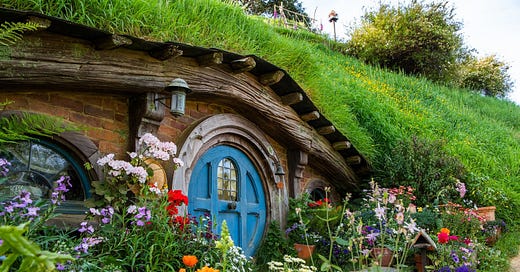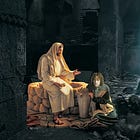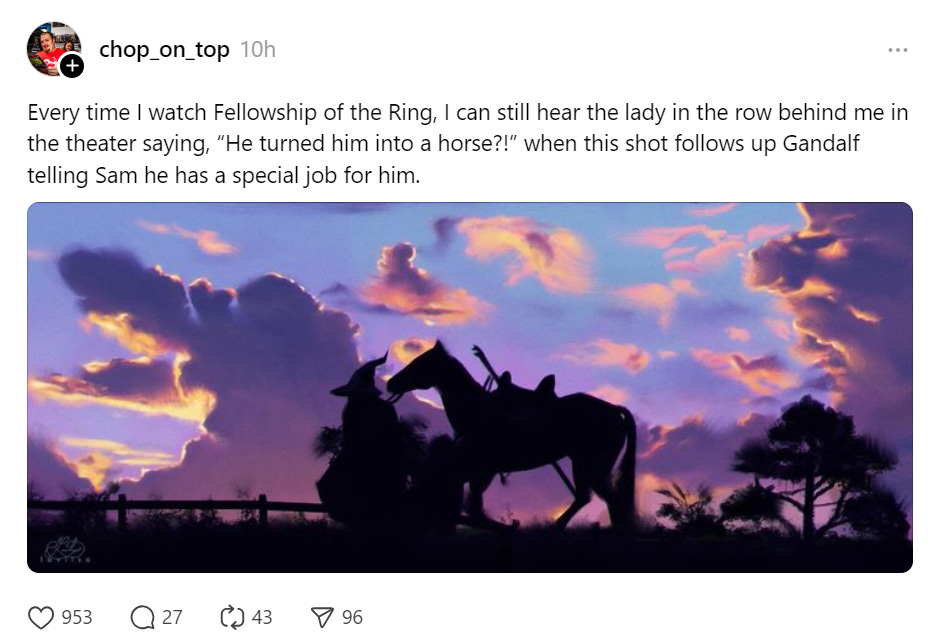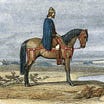Tolkien's Best Gardener
Developing an environmental ethic from Tolkien's works
Mae govannen, friends! Josh here. This week’s newsletter is a guest piece from Rocky Ramsey. Rocky is “a Christian man serving the LORD as a proud husband, father, layman and environmental consultant. He was introduced to Peter Jackson's The Lord of the Rings films as a child and fell in love with the story. He found the themes even more profound and moving when he became a Christian and started to study Tolkien more deeply which has benefited his life greatly. You can find his work at For The King Blog and For The King Podcast, as well as a side project called Heritage Permaculture which is pertinent to the topic of today’s article.”
In today’s piece, he examines the way several key characters in The Lord of the Rings interact with the environment and seeks to pull out some principles from the story for us today. I found the article fascinating and thought-provoking and think we all will have our own takeaways from it. Enjoy!
Tolkien’s Best Gardener
Developing an environmental ethic from Tolkien's works
by Rocky Ramsey
"Ere iron was found or tree was hewn,
When young was mountain under moon;
Ere ring was made, or wrought was woe,
It walked the forests long ago."
-Gandalf
Two enigmatic character in The Lord of the Rings are the white wizard, Saruman, and Tom Bombadil. These characters both boast immense strength and power, and play pivotal roles in the quest to destroy the ring. However, the goal of this article is not to look explicitly at their interactions with the Ring of Power, but rather to explore their methods of gardening. Throughout this article I will use the term gardening more expansively, focusing on the principles and ethos of gardening rather than just the cultivation of plants. Keep an eye out for extracted principles throughout the article.
Saruman the Ent Slayer
They come with fire, they come with axes... gnawing, biting, breaking, hacking, burning! Destroyers and usurpers, curse them!
&
Quickbeam gave a cry “The tree-killer, the tree-killer!” Quickbeam is a gentle creature, but he hates Saruman all the more fiercely for that: his people suffered cruelly from orc-axes.
I want to discuss Saruman first, and use him as the backdrop for Mr. Tom Bombadillo. The light shines brightest in the darkness, so let’s explore the once white wizard, turned ally of the enemy, and how his interactions with nature changed for the worse. If you are familiar with the story of The Lord of The Rings, you know the pivotal role the Ents play in the destruction of Isengard. This Ent invasion doesn’t generate out of thin air, but stems from Saruman’s gardening method of Fangorn Forest. Treebeard, one of the chief Ents, recounts a time when Saruman was a lover of the living things of old:
'But Saruman now! Saruman is a neighbour: I cannot overlook him. I must do something, I suppose. I have often wondered lately what I should do about Saruman.'
'Who is Saruman?' asked Pippin. 'Do you know anything about his history?'
'Saruman is a Wizard,' answered Treebeard.... 'He was reckoned great among them, I believe. He gave up wandering about and minding the affairs of Men and Elves,... a very long time ago: and he settled down at... Isengard.... He was very quiet to begin with, but his fame began to grow. He was chosen to be head of the White Council, they say; but that did not turn out too well. I wonder now if even then Saruman was not turning to evil ways. But at any rate he used to give no trouble to his neighbours. I used to talk to him. There was a time when he was always walking about my woods. He was polite in those days, always asking my leave... and always eager to listen. I told him many things that he would never have found out by himself; but he never repaid me in like kind. I cannot remember that he ever told me anything. And he got more and more like that; his face, as I remember it — I have not seen it for many a day — became like windows in a stone wall: windows with shutters inside…'
As one of the oldest species in middle earth, the Ents view Saruman as “young.” Saruman once sought them for wisdom, companionship, and love. However, Treebeard recognizes that Saruman's demeanor towards nature changed. His heart grew cold and he viewed the Ents and Fangorn Forest no longer as intrinsically valuable. Instead, he viewed them as worthless and used them as a means to his end. Consider our first principle to extract from the story:
Principle #1 Love the old things in and of themselves, because they are a creation of Eru (God). They are ends in themselves and not means to an end.
Fangorn Forest was a sprawling, mature, old garden. The Ents were tree-herders and directed this garden. Saruman himself was a gardener, accompanying Treebeard through the ages in the task of gardening. He may not have shepherded the trees himself, but he played a part in the whole task of “gardening” from his fortress, Orthanc. Every person is tasked with being a cultivator of living things, whether actively (gardening proper) or passively (gardening via one’s environmental ethic). To apply this, consider our second principle:
Principle #2 Every person ought to have an established ethic for approaching the environment. As a Christian, Tolkien derived his ethic from the Bible and wove it into The Lord of The Rings.
Saruman once upheld these two principles throughout the ages of Middle-earth. During the third age, when The Lord of The Rings is set, he is enticed by the Ring of Power and changes his environmental ethic completely. He changes his approach to gardening Fangorn Forest (violation of principle #2). He once walked with Treebeard and approved of, nay, loved the old things. But now Saruman is only concerned with the present. He is concerned with productivity, results, and ultimately power. When he begins amassing an army to destroy the people of Rohan, he knows he cannot do it without sacrificing something. He surveys the resources at his footsteps and settles on Fangorn Forest. How else will the furnaces remain lit for days on end to create an army ready to destroy the insubordinate, horse-loving fools of Rohan? Rather than sacrificing for the benefit of others, Saruman sacrifices OTHERS for his own benefit (violation of principle #1). We will revisit this motif when we consider Bombadil.
"'I think that I now understand what he is up to. He is plotting to become a Power. He has a mind of metal and wheels; and he does not care for growing things, except as far as they serve him for the moment"
&
"Wizards ought to know better: they do know better. There is no curse in Elvish, Entish, or the tongues of Men bad enough for such treachery. Down with Saruman!"
-Treebeard
Bombadil, The Master
Now let’s turn to the crowd favorite, Timbothy Bombadillo! We first meet Tom as the hobbits travel across the shire in an attempt to reach Bree. They stop to rest under a tree on their journey, however, it is no ordinary tree… this is Old-Man-Willow and he’s got quite an attitude. The forest knows this, but the hobbits, unfamiliar with this neck of the woods, are completely unaware of his reputation. Suddenly, Merry and Pippin find themselves entangled by Old-Man-Willow, on the verge of being consumed.
‘Help!’ cried Frodo and Sam running towards him with their hands stretched out.
Whoa! Whoa! steady there!’ cried the old man, holding up one hand, and they stopped short, as if they had been struck stiff. ‘Now, my little fellows, where be you a-going to, puffing like a bellows? What’s the matter here then? Do you know who I am? I’m Tom Bombadil. Tell me what’s your trouble! Tom’s in a hurry now. Don’t you crush my lilies!’
‘My friends are caught in the willow-tree,’ cried Frodo breathlessly.
‘Master Merry’s being squeezed in a crack!’ cried Sam.
‘What?’ shouted Tom Bombadil, leaping up in the air. ‘Old Man Willow? Naught worse than that, eh? That can soon be mended. I know the tune for him. Old grey Willow-man! I’ll freeze his marrow cold, if he don’t behave himself. I’ll sing his roots off. I’ll sing a wind up and blow leaf and branch away. Old Man Willow!’
We see Tom Bombadil come to the hobbits’ rescue, but not in any conventional way. Samwise suggested a more Saruman-like approach, in using an axe to hew Merry and Pippin out, or a fire to burn them out. Frodo and Sam kindle a small fire, but Old-Man-Willow squeezes his victims all the more to disincentivize the hobbits’ crude hope for salvation.
How does Tom Bombadil provide salvation? He surprises us with song and dance. Notice the intense care that Bombadil has for the forest, evidenced first by the lilies he warns the hobbits not to crush, and then by his honorable treatment of Old-Man-Willow. He bent the will of the tree to the will of his own to free the hobbits.
However, Saruman also bends the will of Fangorn Forest to his own, so what is the difference? The answer lies in Goldberry’s response to Frodo’s questioning at Tom’s woodland home,
“ . . . who is Tom Bombadil?”
“He is,” said Goldberry, staying her swift movements and smiling.
Frodo looked at her questioningly. “He is, as you have seen him,” she said in answer to his look. “He is the Master of wood, water, and hill.”
“Then all this strange land belongs to him?”
“No indeed!” she answered, and her smile faded. “That would indeed be a burden,” she added in a low voice, as if to herself. “The trees and the grasses and all things growing or living in the land belong each to themselves. Tom Bombadil is the Master. No one has ever caught old Tom walking in the forest, wading in the water, leaping on the hill-tops under light and shadow. He has no fear. Tom Bombadil is master.”
Tom is the master of the woods.1 Saruman is the dominator of the woods. Both are exercising authority but the fount and source of that authority come from radically different places. Bombadil bends the forest to his will in such a way that each living thing in the forest is still oriented to its greatest good and exercising its own will. They still belong to themselves, but Tom helps them achieve their greatest good. Saruman detracts from Fangorn forest’s natural telos and disrupts its nature. Tom builds the forest, but Saruman destroys the forest. This will help us revisit that point I teased earlier.
Bombadil cultivates his “garden” for its own appointed end. He doesn’t hijack its design for his own personal gain, but rather directs the forest (and his wife Goldberry) to their greatest appointed ends and joy. He sacrifices his time and energy for the betterment of others (which does not neglect his own betterment), rather than forcing others to sacrifice for his own personal gain.
Let nothing be done through selfish ambition or conceit, but in lowliness of mind let each esteem others better than himself. Let each of you look out not only for his own interests, but also for the interests of others.
— Philippians 2:3-4 NKJV
As a devout catholic, Tolkien was riffing on a biblical concept. To truly exercise dominion, especially as a gardener of God’s created world, we must become masters and not dominators who are myopically concerned with power. This is part of why Bombadil could care less about the Ring of Power and why he treats it as a silly little gimmick: because he understands true power. He is a master and masters aren’t enticed by distortions of power.
Modern Day Applications
As we look around us today, we can clearly see massive ecological issues. This ties in to the idea of power that Tolkien so masterfully encapsulates and signifies in the Ring of Power. When we see humans destroying the environment for their own gain, we can probably find a root desire for power. The gardening method of modern man is pure domination of the environment. We dominate plants and their associated “pests” via herbicides and pesticides. Just like Saruman, we decimate entire ecosystems for productivity and power.
Let's ponder a few more examples. Please keep in mind that these are my own specific points of application based on the principles above. I fully expect differences in application and I welcome your inquiry into these matters.
Clear cutting neighborhoods for cookie cutter homes
The elves of Lothlorien or Mirkwood and the hobbits of the Shire built their homes integrated into the environment rather than cutting everything down. Yet in modern day, we plow through the environment so we can maximize every square inch for efficiency. The modern neighborhood has no character, but is full of “cookie cutter” homes. We love the Shire in part because each house is unique and the contents within are unique. When Bilbo comes back to his home after the tale of The Hobbit, he finds his belongings are being pawned off under the presumption that he is dead.
…in the end to save time Bilbo had to buy back quite a lot of his own furniture. Many of his silver spoons mysteriously disappeared and were never accounted for…”
These belongings were irreplaceable things in an irreplaceable dwelling. Our modern day development creates replaceable things with replaceable dwellings in a replaceable environment. Saruman’s devasting works extend into the scourging of the Shire when many of the old trees and dwellings are destroyed. Modern homes have Saruman’s imprints all over them.
To avoid being misunderstood, I want to clarify that I believe it is permissible to cut down trees. For instance, beavers innately cut down trees without doing anything wrong. But I do believe that we must approach an ecosystem with a designated framework to assess whether to cut down a tree. If we are to mimic Bombadil's mastery, then we ought to only cut down a tree that orients an ecosystem to its greatest good. We prune plants all the time for the flourishing of the plant — we can also do this at the ‘forest’ level and prune the forest by cutting down a few weak trees to make way for greater flourishing. We can even cut down perfectly healthy trees, like the elves would have, for development. I want our development to be guided by Bombadil’s mastery rather than Saruman’s dominion. Both mastery and dominion involve cutting down trees, but to what extent and what end makes all the difference.
City Development
Men, who above all desire power, build magnificent structures and cities, but usually at the cost of the environment. I postulate that with intentional planning, we can build large cities integrated into the pre-existing environment. There is nothing wrong with cities, they just need to be sculpted correctly. The glory of Minas Tirith was that the city was built into a mountain, an application of Bombadil-like mastery rather than a Saruman-like domination.
Uber Efficient Mono-crop Farming
Modern day agriculture is purely for efficiency and mechanization. Every field is designed for a harvester to come through, driving between the rows, to harvest as much crop as possible. There is nothing beautiful about a farm field, not to mention the yearly destruction of the soil. This bears more semblance to Saruman’s dealings with the Ents than Bombadil’s mastery of the woods. Bombadil gardened the Old Forest in such a way that no bare soil was ever seen. Modern farming techniques create a 100-year cataclysmic event driving an ecosystem back to primary succession on a yearly basis.
Concluding Remarks
As we draw to a close I think it is fitting to wrap up with the other master gardener in Tolkien’s story, lest we leave any stone unturned. Samwise Gamgee, brave Sam, was Frodo’s gardener on Bag End. It was the act of gardening that led Sam to “drop eaves,” on Gandalf and Frodo, which eventually led to grand adventure. It is fitting that Sam’s adventure starts in a garden, as gardening itself is an adventure. Each years’ growth requires humble submission to the whims of nature. You are at the weather’s bidding and at the mercy of the local rabbits, insects, birds, and any other creature that wonders into your garden. In essence, all you can do is hope, just as Sam maintained an abiding hope throughout his journey with Frodo.
We may never be perfect Masters like Tom, or Lord-forbid, dominating tyrants like Saruman, but we are all like Sam. Dependent, lowly, lacking much authority, but if we are faithful in little, we may destroy the Rings of Power that well up in our own hearts and society every day.
My hope is that this article helps you envision a new dimension of Tolkien’s tales of Middle-earth. You may be wondering if Tolkien intended any of the things I drew out above. Based on some of his personal writings, I truly believe Tolkien had these principles in mind:
It is full Maytime by the trees and grass now. But the heavens are full of roar and riot. You cannot even hold a shouting conversation in the garden now, save about 1 a.m. and 7 p.m. – unless the day is too foul to be out. How I wish the ‘infernal combustion’ engine had never been invented. Or (more difficult still since humanity and engineers in special are both nitwitted and malicious as a rule) that it could have been put to rational uses – if any2
Tolkien hated the effects of industrialization and modernity, especially on the environment. We have definitely missed the mark in many ways and I think Tom Bombadil (and Sam) can help us recover them.
For The King,
Rocky
Have an idea for a guest post here on Jokien with Tolkien? Send me a pitch at jrrjokien@jrrjokien.com and let’s talk about it!
There and Back Again
Wherein I share highlights from previous years of Jokien with Tolkien
Hey there! Josh here again. Around this time last year I shared an imaginary conversation between one Peregrin Took and Jesus that’s a mashup of the Gospel of John 4 and “A Journey in the Dark” from Fellowship.
Check it out here:
Appendices
Here’s a funny story about seeing Fellowship in the theaters that was shared on Threads:
Special shout-out and thank you to Lucas, Sanna L, Matt V, Sherry B, and M.E. W, who upgraded to a paid subscription to the Jokien with Tolkien: Extended Edition this week! Each free edition of Jokien with Tolkien costs time and effort to create, so if you’d like to support me and all the guest writers of Jokien with Tolkien, consider joining the Extended Edition yourself to get access to exclusive content. Hit the button below for more details:
⚔️ Join 8,000+ subscribers in the Jokien with Tolkien community: Subscribe here
🏹 Chosen as a Substack Featured Publication in 2023
🪓 Official merch available in the Jokien with Tolkien store
❌ All typos are precisely as intended
🔗 Links may be affiliate, which is a free-to-you way to support this newsletter where I earn a small commission on items you purchase
📚 Check out my shops on Amazon and Bookshop.org for curated lists of Tolkien content
🗃️ Can’t wait till next Thursday for more content? View the archive
🎯 Interested in sponsoring this newsletter like the above ad? Email me at JRRJokien@JRRJokien.com
📰 Like newsletters? Here’s a selection of some more you may like
For more on this topic read the book “In the House of Tom Bombadil” by C.R. Wiley.
J. R. R. Tolkien, The Letters of J. R. R. Tolkien, HarperCollins Publishers, 77.











Love this so much. I’d love to see more Christians (and humans in general) applying these principles to how we steward the earth.
Interesting read, thank you. I too wish we, in the modernised world, could integrate more with our natural world rather than constantly seek to dominate. We are, however, under certain stresses that the author's imagined world was not. Even the real world that the author lived in had only just began to see the affects of a rapidly increasing population density. One thing there seems no lack of in Middle Earth is space.
But even with that space, it is interesting to note how the author treats the movement of people and the effect migration has on the imagined environment. Perhaps most notably in how the author treats the migration of southerners into the Bree area, causing tensions which are foreshadowed during the hobbit's first stay at The Prancing Pony and ultimately culminate in the scouring of the Shire under the direction/coercion of a power hungry dictator.
I think in his created world, we see the author's idealism. A world in which relatively small groups of people have stewardship over their local environment, seemingly egalitarian in organisation.